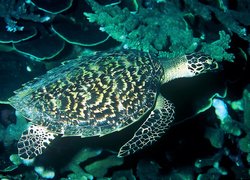Hawksbill turtle
|
|
| Hawksbill Turtle Conservation status: Critical | ||||||||||||||
|---|---|---|---|---|---|---|---|---|---|---|---|---|---|---|
| Missing image Hawksbill_turtle_doeppne-081.jpg Hawksbill turtle (Eretmochelys imbricata) | ||||||||||||||
| Scientific classification | ||||||||||||||
| ||||||||||||||
| Binomial name | ||||||||||||||
| Eretmochelys imbricata Linnaeus, 1766 |
The Hawksbill turtle (Eretmochelys imbricata) is a sea turtle that is distinguished by the following characteristics.
- beak like mouth
- elongated head tapering sharply to a point
- V-shaped lower jaw
- bird like appearance
- alternating gait on land (compared to the Green Sea Turtle or Leatherback Sea Turtle)
- flippers with two claws on each
- heart shaped carapaces on younger age which elongates in maturity
- unusually thick scutes mostly overlapping at the posterior
- plastron scutes are white or yellowish, sometimes with little dark pigmentation
It has also 4 pairs of frontal scutes and the epidermal scutes overlaying the bones build the turtle's shell. Additionally, it has 2 pairs of prefrontal scales.
| Contents |
Scutes
Its carapacial scutes are unusually thick. All hawksbill turtles except the very old ones have sharply serrated carapace at its sides and rear portion. The shell usually has an amber background patterned with irregular combination of light and dark streaks predominantly black and mottled brown colors radiating to the sides.
some figures
- average carapace curve length = 87 centimeters
- weight = can reach up to 80 kilograms
- hatchling's weight = less than 1/2 ounce
- hatchling's carapace length = 1-1/2 inches

Habitat and distribution
Coral reefs are the natural habitat for hawksbill turtles. Caves and ledges around coral reefs provide resting areas throughout the day and night. The are found predominantly in the tropical reefs of Indian, Pacific and Atlantic oceans. Some are found in southern Florida and Hawaii. Very little is known of the turtle's migration patterns.
Feeding & diet
The principal food of hawkbill turtles is sponge. They are considered omnivorous scavengers. Sea anemones and other invertebrates were also found in the stomach of some turtles.
Status
Endangered species. Under the Convention on International Trade in Endangered Species, it is illegal to import or export turtle products, kill, capture or harass hawksbill turtles.de:Echte Karettschildkröte ja:タイマイ nl:Karetschildpad pl:Żółw szylkretowy
